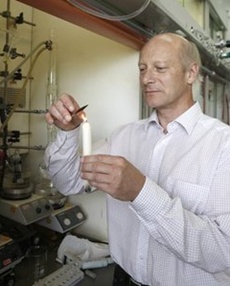Novel membrane for climate protection and medicine technology
14 Dec 2013
Mainz. A research team from the Max Planck Institute for Polymer Research (MPI-P), under the director Hans-Jürgen Butt and his project leader Doris Vollmer, have developed a novel kind of membrane with which gases such as carbon dioxide (CO2) can be concentrated in vapour and liquids as required or separated from them. This scientific breakthrough was announced in the scientific journal Nature Communications.
 | |
| Prof. Butt shows how candle soot is used as a template for the superamphiphobic coating.© Axel Stephan/MPG |
The membrane's properties are based on a strong liquid-repellent (superamphiphobic) coating not only improving gas exchange but at the same time protecting its pores from clogging.
The life-saving oxygenation of blood with heart-lung machines may take place far more reliably than until now.
Butt sees potential for further application in the medical and industrial field, ''Gas exchange is definitely the largest field of application. The membrane could be used in the fields of climate protection as well as in the biomedical sectors'', explains the Max Planck director.
The basics for the superamphiphobic coating result from previous research work done by the surface physicists using candle soot whose combined structure of microscopic pellets has a far better self-cleaning effect than a lotus leaf. Soot is, however, not stable but can be used as a template for resistant coatings.
The Mainz researchers coated the candle soot with silicon oxide and subsequently burnt away the soot. This remaining silicon oxide layer with an average thickness of just 20 nanometers was then coated with a semi-fluorinated silane in order to achieve the water- and oil-repellent effect.
Experiments show that the nanostructural design from the Mainz laboratories not only withstand water and oils but also blood, soap solutions and amines and can be produced with little effort.
Until quite recently this property was hardly conceivable; in Mainz it was given the name „superamphiphobic'' as the logical deduction from the opposite of „amphiphilic'', which describes substances which like water as well as oil.
A fine mesh of stainless steel is used as a membrane substrate onto which the superamphiphobic layer is brought. During gas exchange the nanostructured side of the membrane comes into contact with the liquid while at the same time gas is transported past the back side.
The gas molecules drift in between the gaps of the highly porous network. High gas exchange is reached even with a low flow rate thereby lowering the risk of thrombosis when blood is fed with oxygen. The particular advantage? The membrane pores do not clog. In tests, compared with Teflon, blood did not leave any traces on the membrane even after several hours of contact – an elementary requirement for application in heart-lung machines.
 | |
| The superamphiphobic coating prevents blood sticking on the membrane. © Nature 2013 |
With the gas exchange rates achieved from experiments encouraging industrial applications can be expected, including enrichment of CO2. With this membrane can not only enrichment but also filtration processes be carried out. For example, fine particles from the air were filtrated and fixated in limewash and water. CO2 could pass through the membrane in amine solutions, an established CO2 storage medium, which is an important step on the road to final deposition of CO2.
Universal liquid-repellent surfaces offer an exciting field of research. On the one hand, they enable a better understanding of fundamental function principles of surface coating, interaction of liquids with solids and flow characteristics of liquids.
On the other hand, the phenomena superamphiphobicity is interesting, but still largely unexplored, for the application in industry and medicine or for climate protection.













.jpg)






.jpg)









